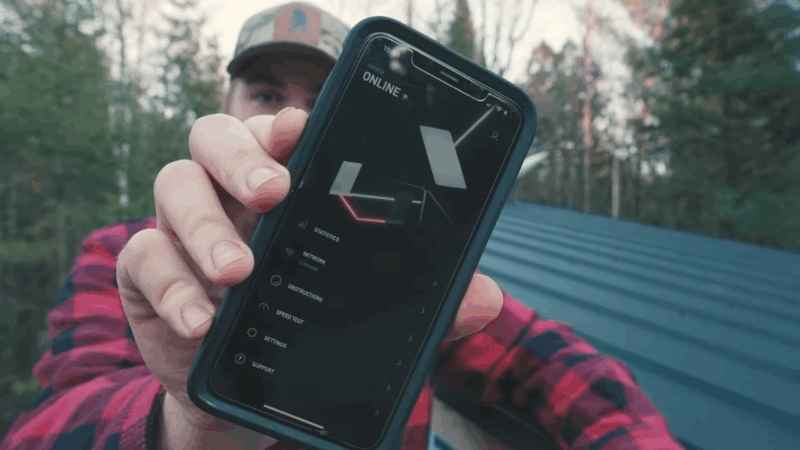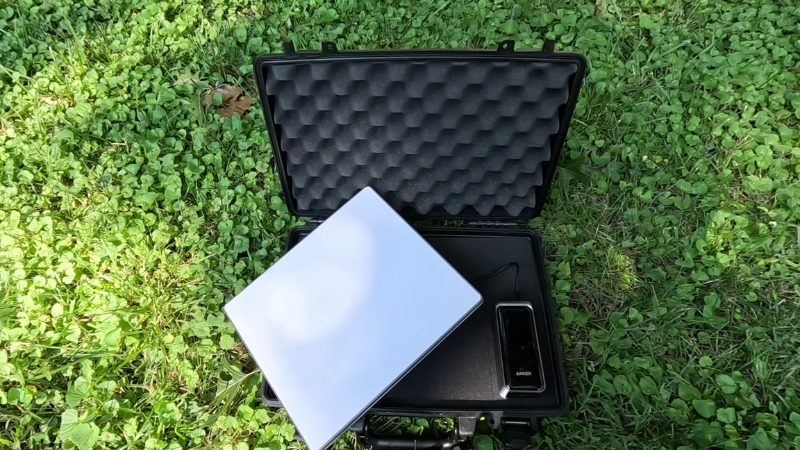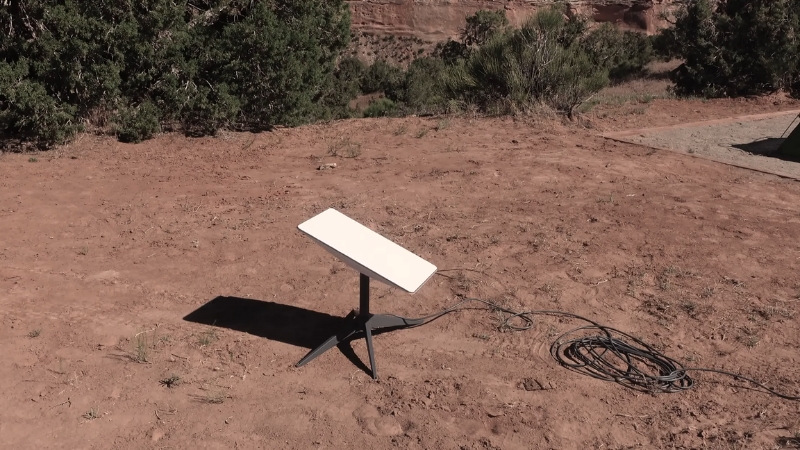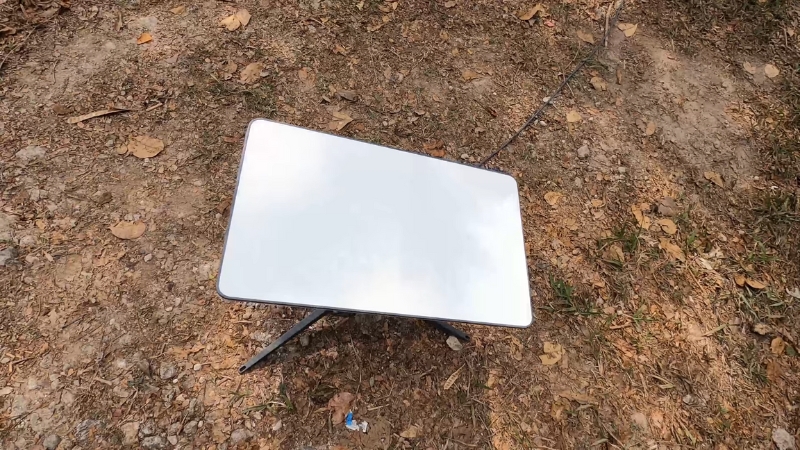Starlink Roam is currently the only viable option for reliable broadband internet access in remote, off-grid locations where cell towers do not reach.
Designed for travelers, campers, off-grid residents, boaters, and overlanders, Starlink Roam uses low-Earth orbit (LEO) satellite technology to deliver speeds of 30 to 100+ Mbps with latency low enough to support video calls, streaming, remote work, and emergency communications—even in places with zero cellular signal.
Unlike traditional satellite services, which are slow and limited in mobility, Starlink Roam works across most of the world and allows you to set up in minutes wherever you can see the sky.
How It Works
Starlink Roam includes a compact dish (standard or mini) and a Wi-Fi router. It uses the same LEO satellite constellation that powers other Starlink services, but with flexible mobility features.
You simply place the dish in an open-sky location, power it via AC or DC, and connect using the Starlink app. The system auto-levels and searches for satellites, usually going online within 5 to 10 minutes.
This is not cellular tethering or a mobile hotspot. It is a direct-to-satellite internet link that bypasses all terrestrial infrastructure. That’s why it works in the desert, in the mountains, and deep in forested zones—anywhere the sky is visible.
Component
Function
Notes
Starlink Dish
Tracks satellites, receives signal
Mini model weighs ~3 lbs; compact and portable
Wi-Fi Router
Distributes internet via a local network
Can connect to AC power or vehicle battery via an inverter
Starlink App
Controls settings, updates firmware
Required for setup and basic diagnostics
Satellite Network
Provides low-latency global coverage
Uses thousands of LEO satellites below 600 km altitude
Plans and Pricing: Flexible, International-Ready
Starlink Roam offers flexible monthly billing with two main tiers. The “Regional Roam” plan is best for users staying within one continent, while the “Global Roam” plan allows usage in multiple countries.
Plan
Monthly Price (USD)
Data Policy
Best For
Roam Regional
$150/mo
Unlimited in-region
Overlanders, RV travelers
Roam Global
$200/mo
Unlimited global roaming
World travelers, expedition use
There is also a hardware cost:
- Standard Dish Kit: USD 599
- Starlink Mini (available in select regions): $599–USD 999, lighter and more portable
- Shipping and taxes may vary by region.
Billing is month-to-month, and you can pause or resume service anytime using the app. This makes it suitable for seasonal use.
Performance: Real-World Speeds and Limitations

In the field, Starlink Roam typically delivers 30 to 100 Mbps download and 10 to 20 Mbps upload, with latency between 25–60 ms. This is more than enough for Zoom calls, Netflix streaming, remote desktop work, and even light online gaming.
However, Starlink Roam users are of lower priority on the network compared to residential users. That means performance may dip during congestion, such as in a crowded RV park. In wilderness areas with few users, performance is consistently strong.
Metric
Starlink Roam (Typical)
Download Speed
30–100 Mbps
Upload Speed
10–20 Mbps
Latency
25–60 ms
Downtime Risk
Low in clear-sky zones
Keep in mind:
Use Cases: Who Is Starlink Roam Really For?
View this post on Instagram
1. Overlanders & Vanlifers
Roof-rack installs or fold-out tripods bring 40 – 90 Mbps to Sprinter offices. A 200 W solar array feeding a 100 Ah LiFePO₄ bank covers the dish’s 4 – 6 Ah draw per workday. In-motion mode (up to 160 km/h) lets passengers upload reels or handle client tickets while rolling.
Some content-creator vans even offset hardware costs by quietly sharing how-to videos or gear lists that reference Starlink’s affiliate program—readers who buy through those links help fund new road miles at no extra cost to themselves.
2. Wilderness Camps & Researchers
Biologists in Patagonia, wildfire-monitor teams in California, and archeologists in Jordan have all adopted Starlink Roam for field stations where line-of-sight radios or microwave repeaters are impossible.
One terminal on a ridge can backhaul terabytes of sensor data or 4 K trail-camera streams to a university lab in real time, shrinking weeks of manual retrieval to hours.
Researchers appreciate that the dish stores easily in a Pelican case and weighs under 5 kg, so a two-person crew can hike it into a plot, drop a lightweight 60 W folding solar mat, and begin uploading by lunch.
The ability to pause billing between field seasons keeps grant budgets predictable. Because the network is encrypted end-to-end, sensitive ecological or cultural heritage data is no longer entrusted to public Wi-Fi on the drive home.
3. Emergency & Disaster Response

When terrestrial backbones fail, bandwidth becomes a lifeline for coordination and triage.
During the 2023 Türkiye–Syria quake and the 2024 Atlantic hurricane season, volunteer groups such as Team Rubicon and ITDRC staged with pallets of Starlink kits; a generator or 1 kWh power station plus a Roam dish restored IP phones, mapping apps, and drone telemetry to incident-command centers in under 30 minutes.
Because Roam terminals self-orient, non-technical volunteers can set them up while specialists focus on search-and-rescue. The equipment rides in a carry-on case, avoids spectrum-licensing headaches, and can be handed to a local clinic once the main fiber routes come back online, providing weeks of telemedicine capacity during recovery.
4. Boaters & Mariners
For inland cruisers and coastal sailors, Roam closes the connectivity gap between patchy 5 G shore coverage and expensive maritime VSAT. Users mount the flat high-performance dish on an aft arch or cabin top, wire it into the 12/24 V DC bus, and enjoy 30–70 Mbps within about 50 km of shore.
The Roam plan’s 60 days per year of “Ocean Mode” is enough for seasonal passages or fishing expeditions; after the allotment, you either pause offshore usage or upgrade to the Maritime tier. Latency remains low enough for video calls to family back home, while weatherfax downloads that once took 20 minutes arrive in 20 seconds.
Salt spray demands a quick freshwater rinse at dock, and most skippers add a $30 Starlink-to-Ethernet adapter so the router can live dry inside the nav station while a rugged PoE injector serves deck cameras and AIS servers.
Powering Starlink Roam Off-Grid
@chorsin_yip Stay Connected. Anywhere. Power your Starlink Mini for up to 9 hours — off-grid, on the move, and totally cable-free. ✔ Lightweight clip-on battery ✔ Built for camping, RVing, flying & emergencies ✔ Smart protection & waterproof (IP65) Go further. Stay online. Shop now at ravion.us #StarlinkMini #OffGridPower #RVLife #CampingGear #Overlanding #PilotGear #StayConnected #SatelliteInternet #PortablePower #WirelessFreedom #EmergencyPrep #Boondocking #AdventureReady #Ravion#portable battery#compactbattery ♬ OK – Joey Valence & Brae
Starlink hardware uses 50–75 watts, meaning you’ll need about 1.5 kWh per day to operate it continuously. For off-grid usage, combine it with:
Power Option
Runtime Estimate
Jackery Explorer 1000
12–16 hours per charge
300W Solar with Storage
Infinite w/ sun exposure
12V Vehicle Inverter
Continuous while driving
In critical uses like survival, search-and-rescue, or medical response, this independence from grid infrastructure is what makes Starlink viable.
Advantages vs. Traditional Satellite or Cellular
Feature
Starlink Roam
LTE Hotspot
Legacy Satellite (e.g., HughesNet)
Works in deep wilderness
Yes
No
No
Real broadband speeds
30–100 Mbps
Depends on signal
2–25 Mbps
Latency for calls/work
25–60 ms
If a strong signal
600–900 ms
Portable across borders
Yes
Yes (roaming charges)
No
Upfront gear cost
$599–999
$0–$300
$300–500
Monthly cost
$150–200
$40–120 + roaming fees
$60–120
Downsides and Limitations
Conclusion

Starlink Roam is a powerful solution for people who need internet where no other system works. It is not cheap, but it delivers on its promise: real broadband access in wilderness, deserts, lakes, and mountain zones.
Whether you’re working remotely, managing a mobile team, sailing across the inland waterways, or camping deep in the woods, Starlink Roam ensures your connection stays live.
It even lets you search maps, routes, and nearby campsites when Googling your next vacation spot.
The key tradeoffs are price, power requirements, and weather sensitivity. But if you’re serious about wilderness connectivity—whether for lifestyle, work, or safety—there is currently no better option on the global market.
I’m Annabel, and traveling has always been my passion. My idea of fun? A lot of biking and hiking. From the Himalayas to the local hills, if there’s a path (or not), I’ve probably been there or it’s on my list.







